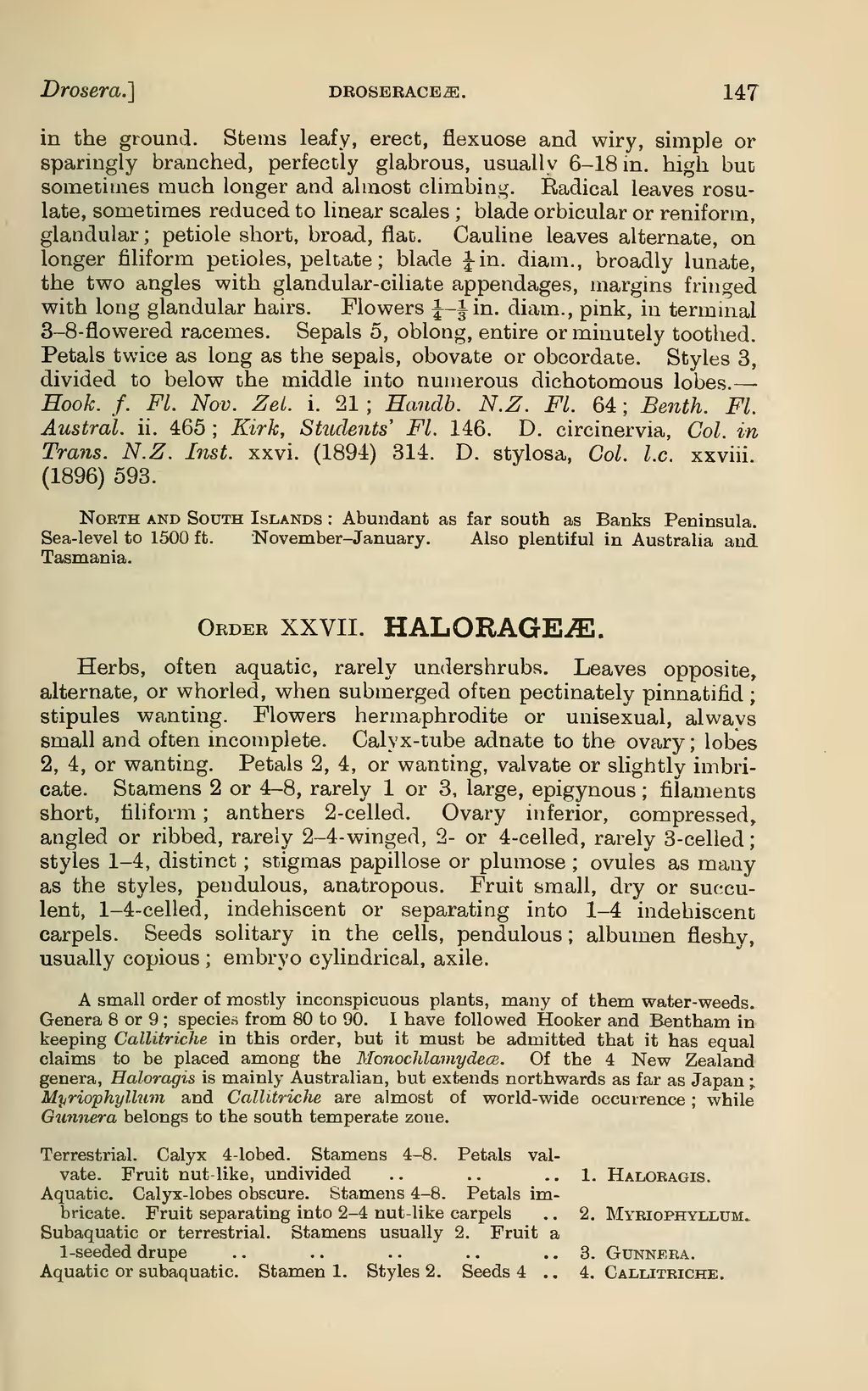in the ground. Stems leafy, erect, flexuose and wiry, simple or sparingly branched, perfectly glabrous, usually 6–18 in. high but sometimes much longer and almost climbing. Radical leaves rosulate, sometimes reduced to linear scales; blade orbicular or reniform, glandular; petiole short, broad, flat. Cauline leaves alternate, on longer filiform petioles, peltate; blade ¼ in. diam., broadly lunate, the two angles with glandular-ciliate appendages, margins fringed with long glandular hairs. Flowers ¼–⅓ in. diam., pink, in terminal 3–8-flowered racemes. Sepals 5, oblong, entire or minutely toothed. Petals twice as long as the sepals, obovate or obcordate. Styles 3, divided to below the middle into numerous dichotomous lobes.—Hook. f. Fl. Nov. Zel. i. 21; Handb. N.Z. Fl. 64; Benth. Fl. Austral. ii. 465; Kirk, Students' Fl. 146. D. circinervia, Col. in Trans. N.Z. Inst. xxvi. (1894) 314. D. stylosa, Col. l.c. xxviii. (1896) 593.
North and South Islands: Abundant as far south as Banks Peninsula. Sea-level to 1500 ft. November–January. Also plentiful in Australia and Tasmania.
Order XXVII. HALORAGEÆ.
Herbs, often aquatic, rarely undershrubs. Leaves opposite, alternate, or whorled, when submerged often pectinately pinnatilid; stipules wanting. Flowers hermaphrodite or unisexual, always small and often incomplete. Calyx-tube adnate to the ovary; lobes 2, 4, or wanting. Petals 2, 4, or wanting, valvate or slightly imbricate. Stamens 2 or 4–8, rarely 1 or 3, large, epigynous; filaments short, filiform; anthers 2-celled. Ovary inferior, compressed, angled or ribbed, rarely 2–4- winged, 2- or 4-celled, rarely 3-celled; styles 1–4, distinct; stigmas papillose or plumose; ovules as many as the styles, pendulous, anatropous. Fruit small, dry or succulent, 1–4-celled, indehiscent or separating into 1–4 indehiscent carpels. Seeds solitary in the cells, pendulous; albumen fleshy, usually copious; embryo cylindrical, axile.
A small order of mostly inconspicuous plants, many of them water-weeds. Genera 8 or 9; species from 80 to 90. I have followed Hooker and Bentham in keeping Callitriche in this order, but it must be admitted that it has equal claims to be placed among the Monochlamydeæ. Of the 4 New Zealand genera, Haloragis is mainly Australian, but extends northwards as far as Japan; Myriophyllum and Callitriche are almost of world-wide occurrence; while Gunnera belongs to the south temperate zone.
| Terrestrial. Calyx 4-lobed. Stamens 4–8. Petals valvate. Fruit nut-like, undivided | 1. Halogragis. |
| Aquatic. Calyx-lobes obscure. Stamens 4–8. Petals imbricate. Fruit separating into 2–4 nut-like carpels | 2. Myriophyllum. |
| Subaquatic or terrestrial. Stamens usually 2. Fruit a 1-seeded drupe | 3. Gunnera. |
| Aquatic or subaquatic. Stamen 1. Styles 2. Seeds 4 | 4. Callitriche. |

